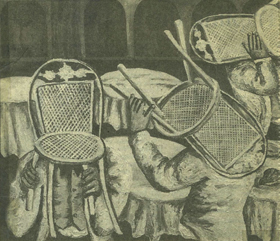MEANING AS A SECOND LANGUAGE: A CONTEMPORARY RUSSIAN INITIATIVE
The New York Times, June 22, 1997
The New York Times, June 22, 1997
| By Helen A. Harison MEANING AS A SECOND LANGUAGE Eilderman and Lowenfeld Galleries, Axinn Library, Hofstra. To Aug.10. |
 Hofstra Museum: "White Chairs" by Natalya Nesterova
Hofstra Museum: "White Chairs" by Natalya Nesterovain the Holofernes role, conquered by a young Russian girl who contemplates his severed head with a mixture of curiosity and satisfaction. Interpreting this work strictly in terms of abstract feelings would do it a disservice. |
|||
| Sponsored by the Society for the Advancement of Understanding Post-Modern Russian Art, the show features 20 Russian artists, most of them expatriates, and one American, whose inclusion is unexplained. According to its catalogue, its purpose, is to debunk the validity of linguistic
theory as a tool for interpreting art. The curator, Alexandre Gerstman, and Sergei Batovrin, one of the exhibitors, assert that for the past 25 years linguistics 'has been the only method of art interpretation. As a counter-attack, they maintain that the works on view "demonstrate abstract significations produced by the relations of forms and meanings." The desire to provoke "abstract feelings" is said to unite all Russian artists wherever they are now living and working. One wonders if the artists themselves would concur with such simplistic characterizations. Even Mr. Batovrin shows in his work a signal disregard for the very BenefitBenefit |
idea he expounds. His painted pastiches of glamour pictures, carefully rendered insects and other fragmentary details are straight our if James Rosenquist’s ironic brand of bill-board inspired Pop Art, far from Mr.Batovrin’s touted “infra-emotional significations.” Natalia Nesterova on the other hand, is clearly interested in the interrelationship of form and feeling. Her faceless figures, painted with expressionistic fervor but lacking the emotional resonance, move like ciphers through settings that have far more character than they do. Their interior loives are hidden from view while their surroundings seem to embody the vitality they lack. Among the best-known émigré artists are Vitaliy Komar and Alexander Melamed, who work as a team. Their sendups of official Soviet art are rooted in the iconography of Socialist Realism and depend for their impact on the viewer’s understanding o their sources. In the current show, their "Judith on the Red Square" casts Lenin BenefitBenefit |
|||



